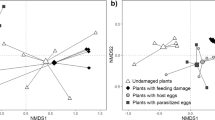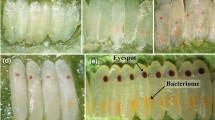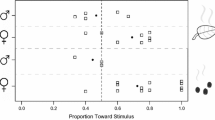Abstract
Understanding the factors influencing host-selection behavior of parasitoids is essential in studies on host-parasitoid ecology and evolution, and in combining sustainable strategies of pest management, such as host-plant resistance and biological control. The effects of host-plant resistance on the olfactory response and parasitism success by Cotesia vestalis, a parasitoid of diamondback moth (Plutella xylostella) larvae were examined. Here, it was demonstrated that host-plant resistance can strongly influence foraging behavior and parasitism success of the parasitoid. In olfactometer experiments, C. vestalis did not differentiate between crucifer plant types with similar levels of susceptibility or resistance to P. xylostella but showed a strong preference for susceptible compared with partially-resistant host plants. The influence of previous oviposition activity varied with the host-plant type experienced by the parasitoid. In cage experiments, C. vestalis preferred to parasitize P. xylostella larvae on a susceptible plant compared with larvae on a partially resistant host plant when exposed to hosts for 24 h. However, this preference appeared to be transitory, and was not found after 96 h exposure. The present study suggests that combining partial host-plant resistance with biological control by C. vestalis for the control of P. xylostella may in some circumstances be antagonistic and negatively affect parasitism success.






Similar content being viewed by others
References
Ahuja I, Rohloff J, Bones AM (2010) Defence mechanisms of Brassicaceae: implications for plant-insect interactions and potential for integrated pest management- a review. Agron Sustain Dev 30:311–348
Benrey B, Callejas A, Rios L, Oyama K, Denno RF (1998) The effects of domestication of Brassica and Phaseolus on the interaction between phytophagous insects and parasitoids. Biol Control 11:130–140
Bogahawatte CNL, van Emden HF (1996) The influence of the host plant of diamond-back moth (Plutella xylostella) on the plant preferences of its parasitoid Cotesia vestalis in Sri Lanka. Physiol Entomol 21:93–96
Bottrell DG, Barbosa P, Gould F (1998) Manipulating natural enemies by plant variety selection and modification: a realistic strategy? Annu Rev Entomol 43:347–367
Bradburne RP, Mithen R (2000) Glucosinolate genetics and the attraction of the aphid parasitoid Diaeretiella rapae to Brassica. Proc R Soc B 267:89–95
Cai Q, Ma X, Zhao X, Cao Y, Yang X (2009) Effects of host plant resistance on insect pests and its parasitoid: a case study of wheat-aphid–parasitoid system. Biol Control 49:134–138
Campan E, Benrey B (2004) Behavior and performance of a specialist and a generalist parasitoid of bruchids on wild and cultivated beans. Biol Control 30:220–228
Campbell B, Duffey S (1979) Tomatine and parasitic wasps: potential incompatibility of plant antibiosis with biological control. Science 205:700–702
Caron V, Myers JH, Gillespie DR (2008) Fitness-related traits in a parasitoid fly are mediated by effects of plants on its host. J Appl Entomol 132:663–667
Chadwick D, Goode J (1999) Insect-plant interactions and induced plant defence. Wiley, Chichester
Ciska E, Martyniak-Przybyszewska B, Kozlowska H (2000) Content of glucosinolates in cruciferous vegetables grown at the same site for 2 years under different climatic conditions. J Agr Food Chem 48:2862–2867
Cortesero AM, Stapel JO, Lewis WJ (2000) Understanding and manipulating plant attributes to enhance biological control. Biol Control 17:35–49
Crawley MJ (2002) Statistical computing: an antroduction to data analysis using S-plus. Wiley, Chichester
Crawley MJ (2005) Statistics: an introduction using R. Wiley, Chichester
Dicke M, van Poecke RP (2002) Signaling in plant-insect interactions: signal transduction in direct and indirect plant defence. In: Scheel D, Wasternack C (eds) Plant signal transduction. Oxford University Press, Oxford, pp 289–316
Dicke M, de Boer JG, Hofte M, Rocha-Granados MC (2003a) Mixed blends of herbivore-induced plant volatiles and foraging success of carnivorous arthropods. Oikos 101:38–48
Dicke M, van Poecke RP, de Boer JG (2003b) Inducible indirect defence of plants: from mechanisms to ecological functions. Basic Appl Ecol 4:27–42
Dicke M, van Loon JJA, Soler R (2009) Chemical complexity of volatiles from plants induced by multiple attack. Nat Chem Biol 5:317–324
Douloumpaka S, van Emden HF (2003) A maternal influence on the conditioning to plant cues of Aphidius colemani Viereck, parasitizing the aphid Myzus persicae Sulzer. Physiol Entomol 28:108–113
Gassmann AJ, Hare JD (2005) Indirect cost of a defensive trait: variation in trichome type affects the natural enemies of herbivorous insects on Datura wrightii. Oecologia 144:62–71
Geervliet JBF, Posthumus MA, Vet LEM, Dicke M (1997) Comparative analysis of headspace volatiles from different caterpillar-infested or uninfested food plants of Pieris species. J Chem Ecol 23:2935–2954
Godfray HCJ (1994) Parasitoids: behavioural and evolutionary ecology. Princeton University Press, Princeton
Gomez KA, Gomez AA (1984) Statistical procedures for agricultural research. Wiley, New York
Hadacek F (2002) Secondary metabolites as plant traits: current assessment and future perspectives. Cr Rev Plant Sci 21:273–322
Harvey JA, van Dam NM, Gols R (2003) Interactions over four trophic levels: foodplant quality affects development of a hyperparasitoid as mediated through a herbivore and its primary parasitoid. J Anim Ecol 72:520–531
Helms SE, Connelly SJ, Hunter MD (2004) Effects of variation among plant species on the interaction between a herbivore and its parasitoid. Ecol Entomol 29:44–51
Hilker M, Meiners T (2002) Induction of plant responses to oviposition and feeding by herbivorous arthropods: a comparison. Entomol Exp Appl 104:181–192
Hopkins RJ, Ekbom B, Henkow L (1998) Glucosinolate content and susceptibility for insect attack of three populations of Sinapis alba. J Chem Ecol 24:1203–1216
Howe GA, Schaller A (2008) Direct defenses in plants and their induction by wounding and insect herbivores. In: Schaller A (ed) Induced plant resistance to herbivory. Springer, Berlin, pp 7–29
Hunter MD (2002) A breath of fresh air: beyond laboratory studies of plant volatile-natural enemy interactions. Agr Forest Entomol 4:81–86
Hunter MD (2003) Effects of plant quality on the population ecology of parasitoids. Agr Forest Entomol 5:1–8
Kalule T, Wright DJ (2002) Effect of cabbage cultivars with varying levels of resistance to aphids on the performance of the parasitoid, Aphidius colemani (Hymenoptera: Braconidae). B Entomol Res 92:53–59
Karimzadeh J, Wright DJ (2008) Bottom-up cascading effects in a tritrophic system: interactions between plant quality and host-parasitoid immune responses. Ecol Entomol 33:45–52
Karimzadeh J, Bonsall MB, Wright DJ (2004) Bottom-up and top-down effects in a tritrophic system: the population dynamics of Plutella xylostella (L.)-Cotesia plutellae (Kurdjumov) on different host plants. Ecol Entomol 29:285–293
Karowe DN, Seimens DH, MitchellOlds T (1997) Species-specific response of glucosinolate content to elevated atmospheric CO2. J Chem Ecol 23:2569–2582
Kopelke JP (2003) Natural enemies of gall-forming sawflies on willows (Salix spp) (Hymenoptera: Tenthredinidae: Euura, Phyllocolpa, Pontania). Entomol Gen 26:277–312
Lambdon PW, Hassall M, Boar RR, Mithen R (2003) Asynchrony in the nitrogen and glucosinolate leaf-age profiles of Brassica: is this a defensive strategy against generalist herbivores? Agr Ecosyst Environ 97:205–214
Lewis WJ, Martin WRJ (1990) Semiochemical for use with parasitoids: status and future. J Chem Ecol 16:3067–3089
Lewis WJ, van Lenteren JC, Phatak SC, Tumlinson JH (1997) A total system approach to sustainable pest management. P Natl Acad Sci USA 94:12243–12248
Liu SS, Jiang LH (2003) Differential parasitism of Plutella xylostella (Lepidoptera: Plutellidae) larvae by the parasitoid Cotesia plutellae (Hymenoptera: Braconidae) on two host plant species. B Entomol Res 93:65–72
Mattiacci L, Dicke M, Posthumus MA (1994) Induction of parasitoid attracting synomone in brussels sprouts plants by feeding of Pieris brassicae larvae: role of mechanical damage and herbivore elicitor. J Chem Ecol 20:2229–2247
McAuslane HJ, Simmons AM, Jackson DM (2000) Parasitism of Bemisia argentifolii on collard with reduced or normal leaf wax. Fla Entomol 83:428–437
Moyes CL, Collin HA, Britton G, Raybould AF (2000) Glucosinolates and differential herbivory in wild populations of Brassica oleracea. J Chem Ecol 26:2625–2641
Orr DB, Boethel DJ (1986) Influence of plant antibiosis through four trophic levels. Oecologia 70:242–249
Paré PW, Tumlinson JH (1999) Plant volatiles as a defense against insect herbivores. Plant Physiol 121:325–331
Pham-Delegue MH, Trouiller J, Bakchine E, Roger B, Masson C (1991) Age dependency of worker bee response to queen pheromone in a four-armed olfactometer. Insect Soc 38:283–292
Porter AJR, Morton AM, Kiddle G, Doughty KJ, Wallsgrove RM (1991) Variation in the glucosinolate content of oilseed rape (Brassica napus L) leaves. I. Effect of leaf age and position. Ann Appl Biol 118:461–467
Potting RPJ, Poppy GM, Schuler TH (1999) The role of volatiles from cruciferous plants and pre-flight experience in the foraging behaviour of the specialist parasitoid Cotesia plutellae. Entomol Exp Appl 93:87–95
Price PW (1986) Ecological aspects of host plant resistance and biological control: interactions among three trophic levels. In: Boethel DJ, Eikenbary RD (eds) Interactions of plant resistance and parasitoids and predators of insects. Wiley, Chichester, pp 11–30
Price PW (1997) Insect ecology. Wiley, New York
Puente ME, Kennedy GG, Gould F (2008) The Impact of herbivore-induced plant volatiles on parasitoid foraging success: a general deterministic model. J Chem Ecol 34:945–958
Ramachandran S, Buntin GD, All JN, Raymer PL (1998) Diamondback moth (Lepidoptera: Plutellidae) resistance of Brassica napus and B. oleracea lines with differing leaf characteristics. J Econ Entomol 91:987–992
Raymond B, Vanbergen A, Pearce I, Hartley SE, Cory JS, Hails RS (2002) Host plant species can influence the fitness of herbivore pathogens: the winter moth and its nucleopolyhedrovirus. Oecologia 131:533–541
Reddy GVP, Holopainen JK, Guerrero A (2002) Olfactory responses of Plutella xylostella natural enemies to host pheromone, larval frass, and green leaf cabbage volatiles. J Chem Ecol 28:131–143
Sarfraz M, Dosdall LM, Keddie BA (2008) Host plant genotype of the herbivore Plutella xylostella (Lepidoptera: Plutellidae) affects the performance of its parasitoid Diadegma insulare (Hymenoptera: Ichneumonidae). Biol Control 44:42–51
Sarfraz M, Dosdall LM, Keddie BA (2009) Fitness of the parasitoid Diadegma insulare is affected by its host's food plants. Basic Appl Ecol 10:563–572
Schmale I, Wackers FL, Cardona C, Dorn S (2003) Combining parasitoids and plant resistance for the control of the bruchid Acanthoscelides obtectus in stored beans. J Stored Prod Res 39:401–411
Schuler TH, Poppy GM, Kerry BR, Denholm I (1999) Potential side effects of insect-resistant transgenic plants on arthropod natural enemies. Trends Biotechnol 17:210–216
Schuler TH, Potting RPJ, Denholm I, Clark SJ, Clark AJ, Stewart CN, Poppy GM (2003) Tritrophic choice experiments with Bt plants, the diamondback moth (Plutella xylostella) and the parasitoid Cotesia plutellae. Transgenic Res 12:351–361
Schuler TH, Denholm I, Clark SJ, Stewart CN, Poppy GM (2004) Effects of Bt plants on the development and survival of the parasitoid Cotesia vestalis (Hymenoptera: Braconidae) in susceptible and Bt-resistant larvae of the diamondback moth, Plutella xylostella (Lepidoptera: Plutellidae). J Insect Physiol 50:435–443
Shiojiri K, Takabayashi J, Yano S, Takafuji A (2000a) Flight response of parasitoids toward plant-herbivore complexes: a comparative study of two parasitoid-herbivore systems on cabbage plants. Appl Entomol Zool 35:87–92
Shiojiri K, Takabayashi J, Yano S, Takafuji A (2000b) Herbivore-species-specific interactions between crucifer plants and parasitic wasps (Hymenoptera: Braconidae) that are mediated by infochemicals present in areas damaged by herbivores. Appl Entomol Zool 35:519–524
Simmons AT, Gurr GM (2005) Trichomes of Lycopersicon species and their hybrids: effects on pests and natural enemies. Agr Forest Entomol 7:265–276
Souissi R, Nenon JP, Le Ru B (1998) Olfactory responses of parasitoid Apoanagyrus lopezi to odor of plants, mealybugs, and plant-mealybug complexes. J Chem Ecol 24:37–48
Stiling P, Moon DC (2005) Quality or quantity: the direct and indirect effects of host plants on herbivores and their natural enemies. Oecologia 142:413–420
Thomas MB (1999) Ecological approaches and the development of “truly integrated” pest management. P Natl Acad Sci USA 96:5944–5951
Thomas MB, Waage JK (1996) Integration of biological control and host plant resistance breeding: a scientific and literature review. TCARCEU, Wageningen
Tscharntke T, Hawkins BA (2002) Multitrophic level interactions. Cambridge University Press, Cambridge
Turlings TCJ, Wäckers F (2004) Recruitment of predators and parasitoids by herbivore-injured plants. In: Cardé RT, Millar JG (eds) Advances in insect chemical ecology. Cambridge University Press, Cambridge, pp 21–75
Ulmer BJ, Dosdall LM (2006) Glucosinolate profile and oviposition behavior in relation to the susceptibilities of Brassicaceae to the cabbage seedpod weevil. Entomol Exp Appl 121:203–213
van Emden HF (1986) The interaction of plant resistance and natural enemies: effects on populations of sucking insects. In: Boethel DJ, Eikenbary RD (eds) Interactions of plant resistance and parasitoids and predators of insects. Ellis Horwood, Chichester, pp 138–150
van Emden HF (1999) Are two methods better than one? Int J Pest Manag 45:1–2
van Etten CH, Daxenbichler ME, Williams PH, Kwolek WF (1976) Glucosinolates and derived products in cruciferous vegetables: analysis of the edible part from twenty-two varieties of cabbage. J Agr Food Chem 24:452–455
van Tol RWHM, van der Sommen ATC, Boff MIC, van Bezooijen J, Sabelis MW, Smits PH (2001) Plants protect their roots by alerting the enemies of grubs. Ecol Lett 4:292–294
Velten G, Rott AS, Cardona C, Dorn S (2007) Effects of a plant resistance protein on parasitism of the common bean bruchid Acanthoscelides obtectus (Coleoptera: Bruchidae) by its natural enemy Dinarmus basalis (Hymenoptera: Pteromalidae). Biol Control 43:78–84
Verkerk RHJ, Wright DJ (1994) Interactions between the diamondback moth, Plutella xylostella L and glasshouse and outdoor-grown cabbage cultivars. Ann Appl Biol 125:477–488
Verkerk RHJ, Wright DJ (1996) Multitrophic interactions and management of the diamondback moth: a review. B Entomol Res 86:205–216
Verkerk RHJ, Wright DJ (1997) Field-based studies with the diamondback moth tritrophic system in Cameron Highlands of Malaysia: implications for pest management. Int J Pest Manage 43:27–33
Verkerk RHJ, Leather SR, Wright DJ (1998) The potential for manipulating crop-pest-natural enemy interactions for improved insect pest management. B Entomol Res 88:493–501
Vet LEM (1999) From chemical to population ecology: infochemical use in an evolutionary context. J Chem Ecol 25:31–49
Vet LEM, Dicke M (1992) Ecology of infochemical use by natural enemies in a tritrophic context. Annu Rev Entomol 37:141–172
Vinson SB (1984) How parasitoid locate their hosts: a case of insect espionage. In: Lawis T (ed) Insect communications. 12th Symp. Roy. Entomol. Soc. London. Academic, London, pp 325–348
Vogelweith F, Thiéry D, Quaglietti B, Moret Y, Moreau J (2011) Host plant variation plastically impacts different traits of the immune system of a phytophagous insect. Funct Ecol 25:1241–1247
Vuorinen T, Nerg A, Ibrahim MA, Reddy GVP, Holopainen JK (2004) Emission of Plutella xylostella-induced compounds from cabbages grown at elevated CO2 and orientation behavior of the natural enemies. Plant Physiol 135:1984–1992
Wallace SK, Eigenbrode SD (2002) Changes in the glucosinolate-myrosinase defense system in Brassica juncea cotyledons during seedling development. J Chem Ecol 28:243–256
Wang XG, Keller MA (2002) A comparison of the host-searching efficiency of two larval parasitoids of Plutella xylostella. Ecol Entomol 27:105–114
Acknowledgements
We thank Panagiotis Vamvatsikos for modifying the olfactometer and Mohammad R. Nematollahi for comments on the draft manuscript; JK was sponsored by the Agricultural Research and Education Organization (AREO), Iran.
Author information
Authors and Affiliations
Corresponding author
Rights and permissions
About this article
Cite this article
Karimzadeh, J., Hardie, J. & Wright, D.J. Plant Resistance Affects the Olfactory Response and Parasitism Success of Cotesia vestalis . J Insect Behav 26, 35–50 (2013). https://doi.org/10.1007/s10905-012-9331-y
Revised:
Accepted:
Published:
Issue Date:
DOI: https://doi.org/10.1007/s10905-012-9331-y




